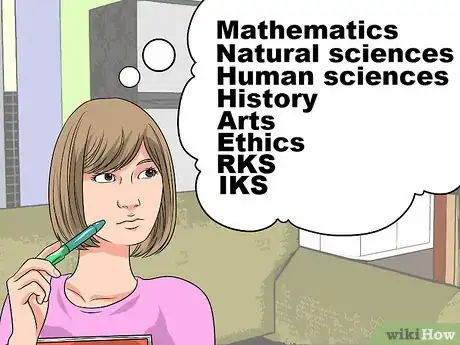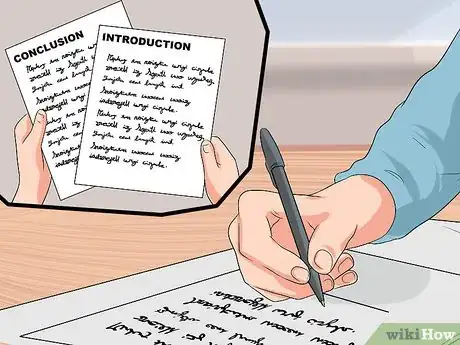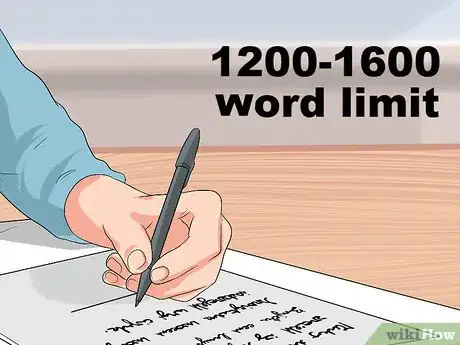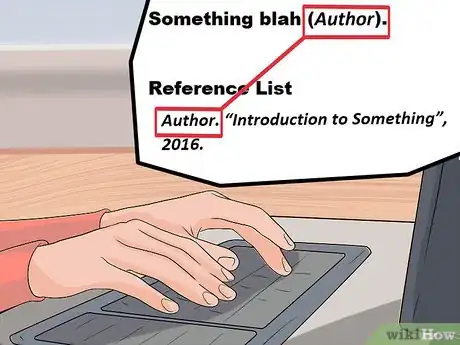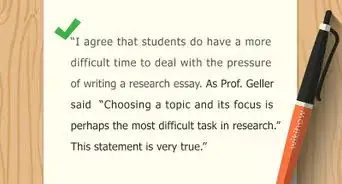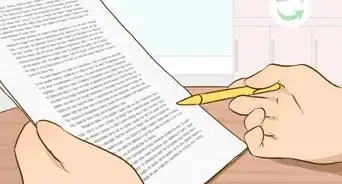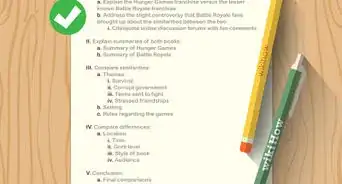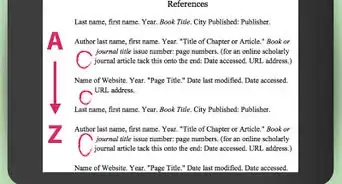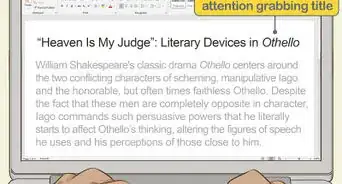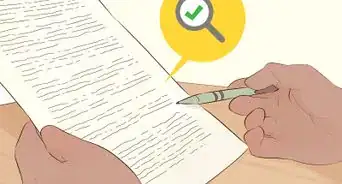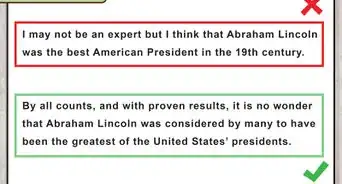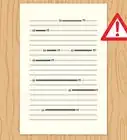This article was co-authored by Stephanie Wong Ken, MFA. Stephanie Wong Ken is a writer based in Canada. Stephanie's writing has appeared in Joyland, Catapult, Pithead Chapel, Cosmonaut's Avenue, and other publications. She holds an MFA in Fiction and Creative Writing from Portland State University.
This article has been viewed 244,954 times.
The International Baccalaureate (IB) Theory of Knowledge essay is a 1200–1600 word essay on prescribed topics or titles created by the IB. As the name suggests, your Theory of Knowledge (TOK) essay should focus on knowledge issues (what is knowledge? why and how do we know things?) and link to other areas of knowledge as well. About two-thirds of your final TOK grade is determined by your score on your TOK essay.
Steps
Choosing Your Essay Title
-
1Understand the structure of a TOK essay. In your essay, you will be expected to compare and contrast different ways of knowing through perception, language, reason, emotion with different areas of knowledge (AOK). The eight areas of knowledge covered in a TOK essay are:[1]
- Mathematics
- Natural sciences
- Human sciences
- History
- The arts
- Ethics
- Religious knowledge systems
- Indigenous knowledge systems
-
2Ask your teacher for the prescribed titles for the TOK essay. These titles, or essay topics, are created by the IB and will ask you to compare and contrast ways of knowing with one to two areas of knowledge. These questions change every exam period, so you can't fully prepare for the essay until you have the correct questions. You will need to remain objective throughout the essay and present both sides of the title in a clear and concise way. For example, two prescribed titles for the 2007 TOK essay were:[2]
- “Compare the roles played by reason and imagination in at least two Areas of Knowledge.”
- “When mathematicians, historians and scientists say that they have explained something, are they using the word ‘explain’ in the same way?”
Advertisement -
3Select a title carefully. Look for a topic that contains an area of knowledge you are familiar with or interested in. But avoid grabbing on to a topic immediately because it sounds appealing or simple. Instead, reach each title carefully on the list and ask yourself several questions:[3]
- Do you understand the keywords or concepts in the title? You may not be clear on what a title is asking you to do. Go through the title and highlight any words or concepts you are unsure about. Some titles will use keywords from TOK courses, such as “belief”, “knowledge” “truth”. You may want to check back on your class notes and consider what these words mean in the context of the title.
- Do you have a strong interest in the title? The title should play to your interests and you should feel you can write about the title with care and diligence. For example, if you are skilled or interested in the arts, you may choose a title like “Compare the roles played by reason and imagination in at least two Areas of Knowledge” and pick the arts as one area of knowledge. Keep in mind, however, you should balance your passion for the title with an objective perspective.
- Do you have something relevant to say about the title? It’s important that you relate the question to the ideas you have covered in your TOK course, as well as the topics you have studied in class, and your own personal experiences or thoughts. The essay should have an objective tone, but you will still need to inject it with personality, passion, and clarity.
-
4Put the title in your own words. Many TOK titles can seem confusing or convoluted when you first read them. You may struggle to understand keywords or terms in the title, or you may not be sure what you are comparing and contrasting in the title. One option is to rephrase the title and break it down into one to two sentences so it becomes more clear.
- For example, in a title like: “When mathematicians, historians and scientists say that they have explained something, are they using the word ‘explain’ in the same way?”, you may rephrase it into two sentences. The title refers to three AOK: mathematics, history, and science. It is then asking you to compare and contrast the way these three AOK use explanation as a way of knowing about a topic or issue.
- By breaking down the title into short sentences, you now have a clearer picture of what the title is asking you to do and how you might go about answering the title sufficiently.
Structuring the Essay
-
1Note the assessment criteria. The IB uses four criteria to grade your essay, each of which carries equal weight. You should have a copy of these criteria and have them in mind as you write your essay. The four areas you will be assessed on include:[4]
- Understanding the knowledge issues: your essay must be focused on the knowledge issues, link and compare at least two knowledge issues, show relevancy between at least two knowledge issues, and demonstrate a sophisticated understanding of the knowledge issues.
- Knower’s perspective: your essay must demonstrate independent thinking, self-awareness, at least two different perspectives, and several supporting examples.
- Analysis of the knowledge issues: your essay must show insight and depth, justify your main points, present arguments and counter-arguments, and explore any assumptions and implications of your topic.
- Organization of ideas: your essay must be well structured, explain key concepts, be factually accurate, and cite references where applicable.
-
2Read the essay instructions. Note the keywords in the essay instructions. You may be told to “assess” or “evaluate” a claim. This means you must consider arguments for and against the title, and take into account any ambiguities or grey areas related to the title.
- You may also be asked “to what extent” or “in what way” a statement is justified. You will then need to present for and against arguments for the statement.
- If you are asked a direct question, your essay should address to what extent or in what ways you are for and against an argument or position.
-
3Brainstorm ideas around the essay title. Before you dive into your outline, get your ideas flowing by taking five to ten minutes to brainstorm. The TOK essay is primarily a reflective essay, so you will want to demonstrate you have thought about the title and are prepared to reflect on and analyze the title.
- Start by doing a general, open brainstorm. Write down everything that comes to mind when you think about the title without passing judgement on any of the ideas, or stopping to read over your brainstorm.
- After five minutes of brainstorming, read over your notes. Identify ideas that relate to each other or that contradict each other. If you are evaluating or assessing a claim in the essay title, create a for column and an against column. Group your brainstorming ideas into either column. Create a third column for grey area ideas, or ambiguities, and place ideas in that column.
- Note any examples of the ideas that you wrote down. For example, you may be addressing a title like: “When mathematicians, historians and scientists say that they have explained something, are they using the word ‘explain’ in the same way?” You may create a brainstorm for each area of knowledge (mathematics, history, science) in relation to the idea of explaining something. You may then use examples of “something” that can be explained in each AOK: a mathematical equation, a historical moment in a battle or a trial, and a scientific theory.
-
4Identify the knowledge issue in the essay title. The knowledge issue will be a question or issue that refers to your understanding of the world, yourself, and others, in connection with the search for knowledge. You are trying to answer the question: “How do you know?” A knowledge issue in an essay title will relate to one or two eight AOK (Mathematics, Natural sciences, Human Sciences, History, The arts, Ethics, Religious knowledge systems, Indigenous knowledge systems) and should examine the potential problems or conflicts in these areas of knowledge or between these areas of knowledge.
- You should also identify the areas of knowledge you will be discussing in your essay. For example, for a title like: “Compare the roles played by reason and imagination in at least two Areas of Knowledge” you may choose two AOK: the arts and science. You may then compare and contrast the function of “reason” and “imagination” in the arts and in science.
-
5Create an outline. Use your brainstorming session and your chosen AOK to create an essay outline. This outline will act as your roadmap and help you structure your essay in a concise and clear way. Your essay outline will be dependent on the type of essay title you choose. If you are writing about one to three AOK, for example, in a title like: “Compare the roles played by reason and imagination in at least two Areas of Knowledge”, you may structure your essay using a simple five paragraph format.[5]
- Paragraph 1: Introduction. You would provide an explanation and interpretation of the title and identify the key terms in the title. You would also state your thesis and explain or identify a knowledge issue related to the title.
- Paragraph 2: First Area of Knowledge. For example, the arts. Discuss how the arts answers the title and provide supporting examples. You should also note any counter-arguments against the title or any limitations of the supporting examples.
- Paragraph 3: Second Area of Knowledge. For example, mathematics. Note how mathematics answers the title and provide supporting examples. You should also note any counter-arguments against the title or any limitations of the supporting examples.
- Paragraph 4: Third Area of Knowledge (if applicable)
- Paragraph 5: Conclusion. Summarize your main ideas and restate your thesis. Conclude by answering the title fully, taking into account the counter arguments and limitations of the areas of knowledge.
- You may also decide to structure your essay based on a main argument and a main counter-argument. Your outline may contain four paragraphs total:
- Paragraph 1: Introduction and explanation of the knowledge issue.
- Paragraph 2: Main argument, with justification and one to two supporting examples.
- Paragraph 3: Main counter-argument, with justification and one to two supporting examples.
- Paragraph 4: Conclusion.
-
6Create a thesis statement. Read over the essay title again, as well as your brainstorming notes and your essay outline, before you create your thesis statement. Your thesis statement is the fundamental claim you are making in the essay, and should link everything in your essay together.
- Some students find it useful to draft their thesis statement once they have finished writing a first draft of the essay. By this point, you will likely have a better sense of the main arguments in the essay and be able to write a clear, concise thesis statement.
- For example, you may need to create a thesis statement for this title: “Compare the roles played by reason and imagination in at least two Areas of Knowledge.” You have chosen two AOK: the arts and mathematics. Consider how reason and imagination function in the arts and in mathematics, as well as the different ways they function in each AOK. Your thesis may be: “Through reason and imagination play an important role in both mathematics and the arts, the imaginative thoughts of mathematicians must be provable, while the imaginative thoughts of artists need only be reasonable.”[6]
Writing the Essay
-
1Use your essay outline as a guide. Focus on expanding each section of your outline, keeping in mind the 1200-1600 word limit for the essay. Your introduction and your conclusion should be the shortest paragraphs in your essay, and the body paragraphs should be the longer sections of your essay.
- You may want to also refer back to your brainstorming notes to identify the supporting examples for your two areas of knowledge, or your main argument and your main counter-argument.
-
2Avoid using dictionary definitions in your essay. You want to show the TOK assessment committee that you are writing a reflective essay, not a textbook definition heavy essay. Don’t rely on dictionary definitions to prove your argument or support a counter argument. This will demonstrate that you did not engage with the topic and bypassed complexities around the topic in favor of generic definitions.
- For example, you may be discussing the use of reason and imagination in the arts. Rather than discuss a familiar artist, like Picasso, or a familiar example of imaginative thinking, like the Sistine Chapel, use supporting examples that feel original and insightful. Though the essay should be objective in nature, it should also feel reflective and personal. Using a supporting example that you feel passionate about, like Pollack’s kinetic movement paintings, or Rodin’s sculptures, will show you have taken the time to explore unique examples.
-
3Cite all external sources using MLA style citations. When you are writing your TOK essay, you will likely need to cite external sources when quoting a source or paraphrasing a source. MLA style is a common citation style used in essay writing. Use this guide when citing sources:[7]
- Reference surprising or little known claims, but not well known facts or commonly held opinions. For example: “The sun is the center of the solar system” is a well known fact you will not need to cite. But “Rodin was a traditionally-schooled artist and had a craftsman-like approach to his work” will require a citation as it is maybe a little known fact.
- Reference any sentences or sections where you are closely following someone else’s train of thought or argument, even in your own words.
- Reference exact quotes, and use quotation marks.
- Be consistent with your citations and the way you reference certain sources.
-
4Read your essay out loud. This will help you determine how precise and clear your language is, and confirm your arguments are well structured and well supported. There should be a natural rhythm to your writing and a certain flow from one section to the next.[8]
- As you read your essay out loud, make sure there are no vague or abstract sentences or terms. You want to ensure you use your 1600 word count in a clear and concise way. Every word will count in your TOK essay.
- Confirm you have addressed knowledge issues in your essay. Your essay should answer the question “How do you know?” and assess the strengths and weaknesses of knowledge claims in at least two areas of knowledge. You should also use arguments and counter-arguments to support your thesis statement, as well as strong supporting examples.
-
5Correct any spelling or grammatical errors. In your final pass through your essay, take the time to address any misspelled words or grammatical errors. Read the essay backwards so you can identify each word and ensure there are no obvious errors in the text.[9]
Community Q&A
-
QuestionShould my TOK essay claim be the claim stated in the question?
 Community AnswerNo, your claim can be opposing the claim stated in the question. However, you need to have adequate evidence for coming to the opposite conclusion.
Community AnswerNo, your claim can be opposing the claim stated in the question. However, you need to have adequate evidence for coming to the opposite conclusion. -
QuestionCan I add pictures in my TOK essay?
 Community AnswerYes, but ask permission from the teacher first.
Community AnswerYes, but ask permission from the teacher first.
References
- ↑ https://ibpublishing.ibo.org/exist/rest/app/tsm.xql?doc=d_0_tok_gui_1304_1_e&part=2&chapter=4
- ↑ http://www.dirk-solies.de/TOK/how%20to%20write%20a%20ToK%20essay%20cambridge.pdf
- ↑ http://www.dirk-solies.de/TOK/how%20to%20write%20a%20ToK%20essay%20cambridge.pdf
- ↑ http://www.dirk-solies.de/TOK/how%20to%20write%20a%20ToK%20essay%20cambridge.pdf
- ↑ http://www.toktalk.net/2009/11/20/starting-and-planning-the-tok-essay/
- ↑ http://www.dirk-solies.de/TOK/how%20to%20write%20a%20ToK%20essay%20cambridge.pdf
- ↑ http://www.dirk-solies.de/TOK/how%20to%20write%20a%20ToK%20essay%20cambridge.pdf
- ↑ http://www.dirk-solies.de/TOK/how%20to%20write%20a%20ToK%20essay%20cambridge.pdf
- ↑ http://www.dirk-solies.de/TOK/how%20to%20write%20a%20ToK%20essay%20cambridge.pdf
About This Article
To write a TOK essay that compares several areas of knowledge, start with an introductory paragraph that explains your title and states your thesis. Then, write 2-3 main body paragraphs, discussing in each a single area of knowledge and how it relates to your title. Try to provide supporting examples in each case, and address any potential counter-arguments, as well. Finally, end your essay with a conclusion that summarizes your main ideas and restates your thesis. When you’re done, check to be sure that you’re within the 1,200-1,600 word limit for the essay. To learn from our English reviewer how to choose an essay title and create your thesis statement, read on!
